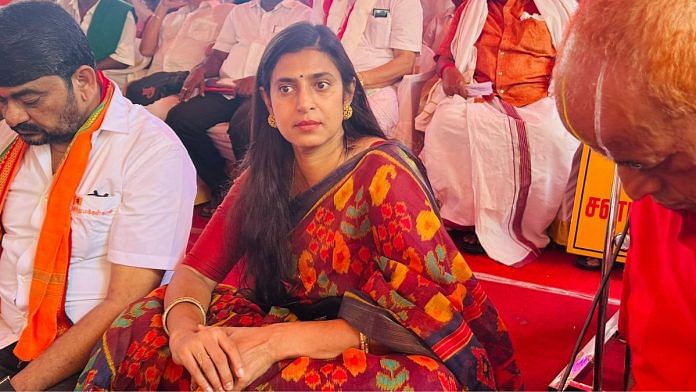Hyderabad: The saga of Tamil actor Kasthuri Shankar’s controversial comments on the Telugu-speaking community living in Tamil Nadu finally ended on 17 November with her arrest in Hyderabad. While it is unclear why she targeted Telugu people in the state, political experts see her comments as a larger effort from the Right-wing to challenge the Dravidian culture in Tamil Nadu by creating rifts between co-existing communities.
Shankar’s remarks were made at an event held by the Right-wing outfit Hindu Makkal Katchi (HMK). Seeking ‘legal protection for Brahmins’, she claimed that the Tamil film industry had denied her roles because she is a Brahmin. Tamil Nadu’s dominant Dravidian culture has often been at loggerheads with the Brahmin community, or the caste system, which is openly spoken against.
“This is a political statement made to create a rift between the existing culture in Tamil Nadu. It is an issue about questioning the Dravidian culture (led by the ruling Dravida Munnetra Kazhagam) in the state. Periyar led the powerful self-respect movement in Tamil Nadu in the past. One of his slogans was, ‘If you see a king cobra or a Brahmin, first kill the Brahmin’. Telugu people there have become a part and parcel of Madras,” said Prof E Venkatesu, a faculty member from the University of Hyderabad’s Political Science department.
In her statement, Shankar said, “When Telugu people, who came to serve the women of kings 300 years ago, claim to be Tamils, who are you to say Brahmins who came long ago aren’t Tamils? This is why they cannot call themselves ‘Tamilargal Munnetra Kazhagam’ and found a term called Dravidians instead,” she said. According to Prof. Venkatesu, she was alluding to the theory about how Aryans from the north settled in the south.
Shankar also reportedly suggested that the Telugu-speaking community’s lineage in Tamil Nadu was from “courtesans who served kings”. Her comments have left many from the Tollywood industry perplexed.
“I honestly do not know why she had to say that, because there is no animosity in general,” said a well-known Tollywood actress from Hyderabad told ThePrint on the condition of anonymity. A few directors and others from the industry also expressed similar sentiments, however, they don’t want to “be dragged” into the controversy.
Also read: Dravidian model vs Hindutva is the next big battle. Rest of India can learn from Tamil Nadu
History of assimilation
The Telugu-speaking regions that now form Andhra Pradesh were part of various regional powers before British rule. In the mid-19th century, these regions were integrated into the British-ruled Madras Presidency. The Andhra regions were part of the Nizam-ruled Hyderabad State until the mid-18th century, when the Northern Circars were ceded to the British East India Company in 1765 as part of a treaty. Other areas gradually came under British control, forming part of the Madras Presidency.
The Nizam of Hyderabad after signing an agreement with the East India Company had agreed to pay them an annual subsidy of Rs 24.17 lakh to maintain British troops in Hyderabad. Since he could not always pay for it, he often borrowed money from a bank—Palmer & Co—which put him in debt for which the Andhra areas were taken away. Telangana however remained with the Hyderabad state.
This part of the history eventually culminated into a demand for a separate Andhra state when the Union government was reorganising states on a linguistic basis. Andhra leaders in fact wanted Madras (now Chennai) as their capital, which was obviously denied by their Tamil counterparts. The state was eventually separated and existed from 1953 to 1956 with Kurnool as its temporary capital.
Interestingly, the States Reorganisation Commission (SRC) had even recommended against creating a larger Telugu-speaking state by merging Andhra and Telangana in 1956. However, finally, it was done and on 1 November 1956 the Andhra Pradesh state was formed.
However, regardless of the socio-political history, Telugu-speaking people in Tamil Nadu, especially in Chennai, “are now part of the social milieu without any discrimination,” said Ashmita Atreya, lead storyteller and historian from Madras Inherited, a not-for-profit organisation that works on the history of Tamil Nadu.
“People here are assimilated, and it is generally understood that historically there were Telugu and Tamil people here. There were Telugu people who were also prominent in the state historically. But there was a feeling that they have not been represented, as there is this underlying sentiment that there is under representation of Telugu people in spite of their work,” Atreya said.
She pointed out that there is a history of assimilation in Chennai, such as in T. Nagar, where Telugu actors NT Rama Rao (NTR) and Savitri once lived. “One of the popular connotations is that T Nagar is Telugu Nagar,” she said.
(Edited by Ratan Priya)






